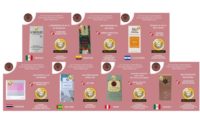Considering the candy’s namesake, the chocolate Mozart Kugeln, or Mozart balls, have a lot to live up to when it comes to presentation.
Echte Reber, which makes the Mozart balls, recently installed two new Gerhard Schubert GmbH TLM Lines to make sure they meet the high standards that come with being named after the prolific composer, Wolfgang Amadeus Mozart.
The lines increase packaging output by about 30 percent, and will allow the company to use a more diverse range of cartons.
But what are Mozart Kugeln chocolates exactly? Reber’s closely guarded family recipe conceals a filling of the finest nougat and fine marzipan with almonds and fresh pistachios, double-coated in alpine milk and dark chocolate.
Based in the town of Bad Reichenhall, Germany, the company still produces its complete range of Mozart Kugeln, confectionery pastries, and confectionery chocolate at its headquarters.
Half a million Mozart Kugeln leave the factory every day and are exported to more than 50 countries — a staggering amount that depends on the right production equipment.
In focus: Flexibility and production reliability
When Reber was looking to upgrade it’s packaging lines, it fractured in its current output, while also keeping an eye on the future by considering the need for smaller batch sizes and increasingly diverse, short-lived packaging types.
So, flexible formats and a fail-safe system were at the top of the list of requirements for Reber Operations Manager Reinhold Kaiser. The new packaging machine had to be able to address all market trends for at least ten years.
At the same time, the manufacturer wanted to retain the tried and test ed, high-quality packaging for its Mozart Kugeln. The chocolates come in carded boxes with separate bases and lids that are erected without glue. Different trays, in formats of 6-packs, 12-packs or other variants, hold the products. And to protect the fine marzipan balls, a cushioning paper is placed on top. Each box also comes with a guarantee card, with which Reber attests to the authenticity of the product.
All these process steps needed to be integrated into the system — as well as quality control and the possibility of aligning the balls in each tray so that the portraits of the world-famous namesake on the printed gold foils are oriented in the same manner.
A customized solution consisting of two systems
It’s an equation Schubert was able to solve, thanks to its modular machine concept.
“The solution consists of two separate packaging machines — one to put the products into the trays and one to make the cartons,” said Markus Vogelmann, sales account manager at Gerhard Schubert GmbH. “This means that our customer can not only process its current product range, but is already equipped for all conceivable future formats.”
Schubert has designed a combination of a picker line and a packing line for primary packaging. So, if single-sort formats need to be packed, the picker line operates. But, if mixed boxes need to be packed, the lateral infeed belts are utilized and the system is switched over to a packing line operation.
For the secondary packaging, i.e. the praline cartons, Reber uses a Schubert cartoner.
It is located as a separate system in the production area, but is directly connected to the upstream pick & place machine from Schubert. Depending on the format, the filled trays either run into the new cartoner or to existing equipment.
“The availability of the packaging solution is exceptionally high due to the separate systems, which can be integrated into the overall production in various ways,” said Vogelmann. “The picker line can also handle special tray formats such as Christmas editions. If one of the lines comes to a standstill for maintenance or the like, production can still continue on the other packaging machine.”
A combination of picker line and packing line
The combined picker line and packing line consists of six machine frames, and the products come directly from wrapping machines via feed belts into the Schubert line.
Several incident-light scanners check the quality of the Mozart Kugeln already wrapped in foil. The Schubert image processing system also detects the film imprint on the wrapping paper and passes the information on to the robots.
Eight pick & place robots then pick up the products from the product belt or optionally from the side belts, turn them to the correct orientation and place them correctly aligned into the trays.
The individually adapted suction tools of the robots ensure exceptionally gentle product handling. For Reber, the machine builders chose the F4 robots from Schubert’s system components.
With their wide working area at right angles to the belt, the Scara robots are especially suitable for this special machine layout and for switching between the picker line and the packing line.
"During the planning process, we worked with Reber and the tray supplier to convert the existing trays to automatically destackable variants,” Vogelmann said.
A cartoner with additional functions
Following the pick & place machine, the filled trays move into the cartoner.
In the compact system consisting of just four TLM frames, the carton bases are erected, the trays are inserted, the padding paper and warranty card are inserted, and the erected lids are applied.
Schubert’s Transmodul transport robot connects all process steps without the need for any interfaces. Up to seven cartons can be filled at the same time.
“All packaging steps now run fully automatically and with a significant increase in performance of more than 30 percent,” Vogelmann said.





